Since the publication of the NACTO Urban Bikeway Design Guide, NACTO has released additional intersection design guidance, including options for signal phasing that may be used with Bicycle Signal Heads.
See this new resource >
Description
A bicycle signal is an electrically powered traffic control device that should only be used in combination with an existing conventional traffic signal or hybrid beacon. Bicycle signals are typically used to improve identified safety or operational problems involving bicycle facilities or to provide guidance for bicyclists at intersections where they may have different needs from other road users (e.g., bicycle only movements, leading bicycle intervals). Bicycle signal heads may be installed at signalized intersections to indicate bicycle signal phases and other bicycle-specific timing strategies. In the United States, bicycle signal heads typically use standard three-lens signal heads in green, yellow, and red lenses.
Bicycle Signal Head Benefits
- Separates bicycle movements from conflicting motor vehicle, streetcar, light rail, or pedestrian movements.
- Provides priority to bicycle movements at intersections (e.g., a leading bicycle interval).
- Accommodates of bicycle-only movements within signalized intersections (e.g., providing a phase for a contra-flow bike lane that otherwise would not have a phase). Through bicycle travel may also occur simultaneously with parallel auto movement if conflicting automobile turns are restricted.
- Protects bicyclists in the intersection, which may improve real and perceived safety at high-conflict areas.
- Improves operation and provides appropriate information for bicyclists (as compared to pedestrian signals).
- Helps to simplify bicycle movements through complex intersections and potentially improve operations or reduce conflicts for all modes. Read More+
Concluding a case study of a bicycle signal head installation in Davis, CA: “Both motorists and bicyclists found the new signal heads to be effective in reducing conflicts between the various modes passing through the intersection. Evaluation of crash data seemed to reflect this as well. For the two-year period before the installation of bicycle signal heads at the intersection of Sycamore and Russell, there were about 16 bicycle and motor vehicle collisions. For the two-year period following the installation, there were only two collisions, neither of which involved bicycles.”
Pedestrian and Bicycle Information Center. (2006.) BIKESAFE: Bicycle Countermeasure Selection System. Publication No. FHWA-SA-05-006, Federal Highway Administration, Washington, DC.
Typical Applications
- Where a stand-alone bike path or multi-use path crosses a street, especially where the needed bicycle clearance time differs substantially from the needed pedestrian clearance time.
- To split signal phases at intersections where a predominant bicycle movement conflicts with a main motor vehicle movement during the same green phase.
- At intersections where a bicycle facility transitions from a cycle track to a bicycle lane, if turning movements are significant.
- At intersections with contra-flow bicycle movements that otherwise would have no signal indication and where a normal traffic signal head may encourage wrong-way driving by motorists.
- To give bicyclists an advanced green (like a leading pedestrian interval), or to indicate an “all-bike” phase where bicyclist turning movements are high.
- To make it legal for bicyclists to enter an intersection during an all-pedestrian phase (may not be appropriate in some cities).
- At complex intersections that may otherwise be difficult for bicyclists to navigate.
- At intersections with high numbers of bicycle and motor vehicle crashes.
- At intersections near schools (primary, secondary, and university).
Design Guidance

| Recommended Features |
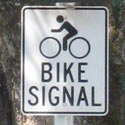 |
A supplemental “Bicycle Signal” sign plaque should be added below the bicycle signal head to increase comprehension. |
 |
Signal timing with bicycle-only indications should consider activating the signal with each cycle prior to implementation with detection. This will increase awareness of the interval for motorists and bicyclists. In a close network of signals, the timing should consider how often a bicyclist will be stopped in the system to insure that undue delay is not a result of the bicycle-only signal. |
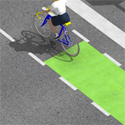 |
Intersection crossing markings should be used where the bicycle travel path through the intersection is unusual (e.g., diagonal crossing) or needed to separate conflicts. |
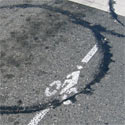 |
Passive actuation of bicycle signals through loops or another detection method is preferred to the use of push-buttons for actuation where practical. Passive actuation is more convenient for bicyclists. If push buttons are used, they should be mounted such that bicyclists do not have to dismount to actuate the signal. |
 |
There are currently no national standards for determining the appropriate clearance intervals for bicycle signals. However, the primary factors in choosing an appropriate clearance interval are bicyclist travel speed and intersection width. At most signalized intersections, vehicular clearance intervals will likely function well for bicyclists. Exceptions requiring consideration include signals along cycle tracks or bicycle facilities that may be likely to serve significant levels of novice cyclists. The following provides general guidance for selecting clearance intervals. This guidance should be tailored to local conditions using engineering judgment. Read More+
- At a minimum, the bicycle clearance interval should be sufficient to accommodate the 15th percentile biking speed (i.e., it should accommodate 85 percent of bicyclists at their normal travel speed). This is consistent with MUTCD guidance on pedestrian clearance intervals.
- Ideally, typical bicyclist speeds (V) should be measured in the field to determine a clearance interval appropriate for local conditions. However, at intersections with level approaches, 14 feet per second (9.5 miles per hour) may be used as a default speed in the absence of local data.
A research study collecting cyclist speeds on 15 trails throughout the United States found that the 15th percentile cycling speed is approximately 9.4 miles per hour.
Federal Highway Administration. (2006). Shared Use Path Level of Service Calculator. Publication: FHWA-HRT-05-138.
- Intersection width (W) should be calculated from the intersection entry (i.e., stop-line or crosswalk in the absence of a stop-line) to half-way across the last lane carrying through traffic.
- Calculate the total clearance interval (Ci) based on the following equation:

- Yellow intervals for automobiles will typically be longer than those needed for bicycles, because of slower bicycle travel speeds. The intersection clearance time needed for bicyclists can be met partly through the automobile yellow interval, as well as through the all-red phase.
- The above guidance should be supplemented with engineering judgment as some wider intersections could be left with extremely long all-red signal phases.
|
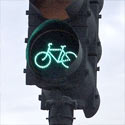 |
Bicyclists typically need longer minimum green times than motor vehicles due to slower acceleration speeds. This time is usually more critical for bicyclists on minor-road approaches, since crossing distance of major roads is typically greater than that of minor roads, and crossings from minor roads are often subject to short green intervals. Bicycle minimum green time is determined using the bicycle crossing time for standing bicycles. Read More+
Some controllers have built-in features to specify and program a bicycle minimum green based on bicycle detection. However, if this is not available, and bicycle minimum green time is greater than what would ordinarily be used, the green time should be increased.
|
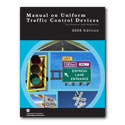 |
Design and operation of bicycle signal heads should consider general MUTCD guidance on standards for traffic signals where applicable (e.g., positions of signal indications; visibility, aiming, and shielding of signal faces). Many of the MUTCD considerations for traffic signals will not apply to bicycle signals. Existing experience with bicycle signal installations in some cities has resulted in post mounted signals being utilized adjacent to the bikeway with a lower overall height. Some existing designs use shields and louvers to limit the driver’s visibility of the bicycle signal to avoid potential confusion. Engineering judgment should be used to ensure that the positioning of bicycle signal heads is optimal for each installation. It is recommended that bicycle signal heads be separated from motor vehicle signal heads by at least two feet to increase comprehension. |
| Optional Features |
 For improved visibility, near-sided bicycle signals may be used to supplement far-side signals. Smaller, half-sized signal heads with 4 inch lenses may be more appropriate in scale for near side installations. For improved visibility, near-sided bicycle signals may be used to supplement far-side signals. Smaller, half-sized signal heads with 4 inch lenses may be more appropriate in scale for near side installations. |
|
 If signal controlled bicycle turning movements are desired, consider pairing the bicycle signal head with a turn signal head to clarify protected, permissive, or restricted turning movements. If signal controlled bicycle turning movements are desired, consider pairing the bicycle signal head with a turn signal head to clarify protected, permissive, or restricted turning movements. |
|
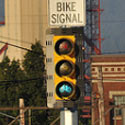 Visual variation in signal head housing for the bicycle signal when compared to adjacent traffic signals may increase contrast and awareness. Visual variation in signal head housing for the bicycle signal when compared to adjacent traffic signals may increase contrast and awareness. |
|
 Near-side bicycle signals may incorporate a ‘countdown to green’ display to provide information about when a green bicycle indication will be provided. This treatment has proved popular in Europe, but there are currently no known installations in the United States. Near-side bicycle signals may incorporate a ‘countdown to green’ display to provide information about when a green bicycle indication will be provided. This treatment has proved popular in Europe, but there are currently no known installations in the United States. |
|
Maintenance
- Bicycle signal heads require the same maintenance as standard traffic signal heads, such as replacing bulbs and responding to power outages.
Treatment Adoption and Professional Consensus
Bicycle signal heads are widely used in Europe and China, as well as the following US cities:
- Alexandria, VA
- Arlington, VA
- Austin, TX
- Davis, CA
- Denver, CO
- Eugene, OR
- Madison, WI
- Minneapolis, MN
- New York, NY
- Portland, OR
- Salt Lake City, UT
- San Francisco, CA
- San Luis Obispo, CA
- Washington, DC
Note that while bicycle signal heads are not currently included in the MUTCD, the National Committee on Uniform Traffic Control Devices has formed a Task Force that is considering adding guidance to the MUTCD on the use of bicycle signals. The State of California has added them to its own version of the MUTCD – Section 4D.104(CA), and the State of Oregon is considering similar legislation.